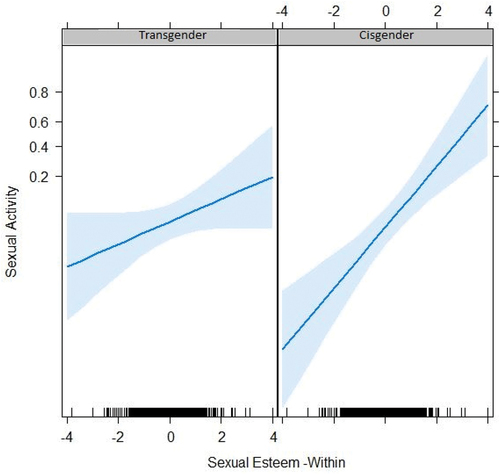Figures & data
Table 1. Participant characteristics and group differences on education, occupation, housing, and number of children.
Table 2. Descriptive statistics on study variables.
Table 3. Multilevel coefficients (β) and standard errors (SE) representing the effects of sexual behavior and sexual openness on sexual esteem and body image on a within- (i.e. daily) and between-subject level.
Figure 1. The daily effect of having masturbated or not (on the x-axis; values represent subject-centered values) on body image (on the y-axis) differed significantly between transgender (left panel) and cisgender (right panel) participants (β = −0.21, SE = 0.09, t(1508) = −2.23, p = .026). Shadings indicate 95% confidence intervals. Note that while the figure suggests there is a positive effect in transgender individuals and a negative effect in cisgender individuals, none of these effects in themselves were significant, and only the interaction reached a significance of p < .05.

Table 4. Multilevel coefficients (β) and standard errors (SE) representing the effects of sexual esteem and body image on sexual behavior and sexual openness on a within – (i.e. daily) and between-subject level.
Figure 2. The daily effect between sexual esteem (on the x-axis; values represent subject-centered values) and the chance of engaging in sexual activity (on the y-axis; values represented on a logit scale) differed significantly between transgender (left panel) and cisgender (right panel) participants (β = 0.63, SE = 0.30, z = 2.11, p = .035). Shadings indicate 95% confidence intervals. Note that the positive effect of daily sexual esteem on the chances of engaging in sexual activity was significant in cisgender participants only.

